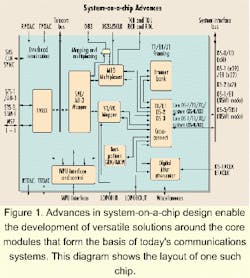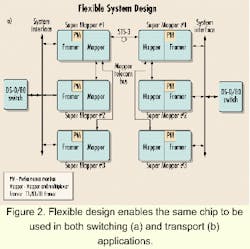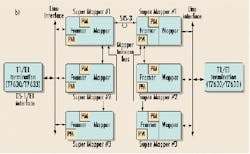Transitions from copper to fiber require reinforcements at the network's edge
Unprecedented growth in data communications is fueling the need for higher bandwidth at both the edge and transport levels.
Amit Banerjee, Lucent Technologies Microelectronics Group
Along with the demand for higher bandwidth comes an increase in the requirement to support channeled, high-bandwidth pipes for termination at the edge. This need highlights the significant advan tage of supporting multiple-access services with high-density edge cards, enab ling the simple connection of copper-based access networks to fiber-based transport layers.
The appetite for bandwidth is being fed by increasing numbers of individuals and corporations wishing to integrate ever more offices, sites, and locations into a seamless environment. Such a requirement for high bandwidth rapidly contributes to the evolution of network systems.
The variety of users and their applications continues to grow with no end in sight. The Internet-requiring voice, data, and multimedia transmissions-is supported by systems generally classified by their location, functions, and interfaces. At the same time, the increase in Web-based services and e-commerce is mandating rapid enhancements in capacity.
Network service providers such as incumbent local-exchange carriers (ILECs), interexchange carriers (IXCs), and regional Bell operating companies (RBOCs) are trying to address the dramatically increased demand for data traffic by deploying dedicated networks for each type of traffic. Unplanned growth in the demand for data networks, based on rapidly evolving but diverse protocols, has prompted the development of separately managed networks and a subsequent increase in capacity based on short-term goals. These overlay networks continue to be scaled up further to address exploding bandwidth requirements.
As telecommunications vendors developed the network to carry time-division multiplexed (TDM), circuit-switched voice traffic, the network was modified to fit the requirements of data traffic using various innovative schemes. However, the volume of data traffic has now outpaced that of voice, resulting in protocols that handle network traffic migrating to a more data-oriented structure. There is a significant push to build packet-switched, data-centric networks. Pack et ized voice and multimedia are being carried over these networks using quality-of-service assurances. Today's edge systems must support a wide range of physical connections at different data rates and protocols.
The T-carrier system is the most popular telecommunications access mechanism in place today. Developed to carry digitized voice over twisted-pair copper lines, T1 in North America and E1 in Europe and Asia are the basic building blocks of the digital-transmission hierarchy. Most communications standards and protocols used today are based on T1/E1 transmission technology and its mapping procedures to scale to higher transmission rates. This also extends to standards for transmission media beyond copper twisted-pair, including coaxial cable, optical fiber, and microwaves.
T1/E1-or, in some cases, T3/E3-is used to connect local exchanges and central offices. Voice is carried over 64-kbit/sec connections (DS-0 or a time slot). Multiple time slots can be linked together for higher-speed (n x 64-kbit/sec) data communications from end terminals or for connecting cellular base stations to the public-switched telephone network. This setup serves to connect local-area-network systems and access wide-area-network systems. Integrated Services Digital Network (ISDN), frame relay, Internet protocol (IP), point-to-point protocol (PPP), Asynchronous Transfer Mode (ATM), and proprietary protocol-encoded data are transported in a reliable manner mapped into this Plesiochronous Data Hierarchy (PDH).
A 4-wire T1/E1 circuit is prone to signal distortion, high bit-error rates, loss of frame, and timing slips. Physical conditions often lead to signal loss due to circuit failures. In response, framing formats feature robust signaling, error detection and fault diagnostic schemes. Individual T1/E1s have independent clocks for transmit and receive functions. Signaling and timing information is preserved as the data passes through the network, based on multiplexing and demultiplexing schemes used for the hierarchy to provide higher rates for transport across the network.The telecommunication and data-communication industries place a high priority on reliability, scalability, and the capability to upgrade, which results in revenue protection and growth. Today's system vendors are working overtime to develop systems that provide improved bandwidth management and quality of service while supporting new applications. These systems are connected with high-bandwidth pipes complete with sophisticated protection and timing mechanisms.
High-bandwidth, fiber-based connections use synchronous standards such as Synchronous Optical Network/Synchronous Digital Hierarchy (SONET/ SDH). These connections multiplex traffic from multiple T-carrier tributaries to switches or between switches and routers at higher rates. SONET standards use synchronous transport signal, level 1 (STS-1-51.84 Mbits/sec), as a basic block for multiplexing or concatenation to higher rates. Overhead data is used for control, management, and diagnostic purposes, while a synchronous payload envelope contains synchronous or asynchronous data from various tributaries, including T-carriers. Reliability and scalability are two of the most important features of this system.
The heavy data load, requiring faster bit rates, has led to the need for the deployment of optical-carrier transmission systems at rates of OC-3 (1.55 Mbits/sec) to OC-192 (10 Gbits/sec). Fiber-optic technology is cost-efficient, lighter, and consumes less power than other access methods, and it is relatively noise-free for high-bandwidth transport. Fiber's most important characteristic is it allows for easier network upgrades. Increasingly, channeled OC-3 to OC-12 (622 Mbits/sec) is used for the transport of T1/E1 (T3/E3) to be terminated back to its components in edge cards or modules in switches and routers.
The insatiable demand for bandwidth results in the deployment of fiber rings with ever-increasing bandwidth capacity. System intelligence is pushed closer to the edge-and closer to customer premises. Today's vendors are accelerating the evolution of system architectures to handle multiple access rates and diverse protocols.
Yet, investments in communication networks are costly, requiring the deployed equipment to serve customer requirements for an extended period of time. This is achieved most often by adding new cards to an existing chassis to keep up with evolving requirements. The egress direction can be upgraded from OC-3 to OC-12, for example, to support higher bandwidth, allowing for a larger number of connections implemented by additional line cards, blades, or network interface cards (NICs). Each service is supported by dedicated and separate cards for DS-1 (1.544 Mbits/sec), E1 (2.048 Mbits/sec), and DS-3 (44.736 Mbits/sec) access speeds for voice, data (ATM, PPP, frame relay), and multimedia. Additional cards are used for redundancy to increase reliability for high-speed communications against circuit failure. Separate design efforts are required for these types of cards.
The scenario is further complicated at the OC-48 (2.5-Gbit/sec) level or higher, since system size and power scale upwards with increased bandwidth. Commercial off-the-shelf devices and application-specific integrated circuits (ASICs) are rapidly evolving due to advances in semiconductor technology that integrate more functions in individual chips.
The economics of technology continues to fuel the advancement of multi-functionality in silicon solutions at a lower cost. What formerly required a board full of components is now available as a single device. However, most of the slots in a rack are still filled with edge-access cards. There is an urgent need for high-density channels or termination of OC-3 and DS-3 to provide connectivity for local-area-network and multiplexed-access services to switches, routers, and other wide-area-network systems. A single card capable of performing all these functions will dramatically reduce inventory and costs due to higher volume production of just one board as opposed to several.Attempts were made to integrate adjacent functions into a single device for ease of use and to reduce interconnects (for example, line interface units and framers, framers and M13, and framers and HDLC controllers). The highest value will be provided by integration of parallel functions (for example, SONET/SDH or DS-3 to DS-1/E1, HDLC, or ATM on the same channel) where only one is chosen at a time. This approach will enable the construction of high-density multiservice cards, provisioned by software commands, which is most important for fiber-to-copper solutions to comply with the standards that have evolved over the decades to meet changing requirements.
Modules are implemented using multiple chips from different vendors on large multilayer boards with higher power consumption, complicated software (which is needed for managing, testing, and debugging), and higher inventory costs. The combination of these factors results in higher development expense, longer time-to-market, and lower product reliability. Additionally, system vendors traditionally develop ASICs to address requirements driven by an inherent interoperability of multiple chips.
To help bridge to existing copper networks, chip man ufacturers are faced with the challenge of providing single-chip solutions for high-speed fiber networks that act as universal adapters between fiber (STS-3/STM-1) and copper (DS-3, DS-2, DS-1, DS-0) standards. Such a device must provide all multiplexing, mapping, and framing functions required by a system in any combination from SONET/SDH to the existing PDH hierarchy (DS-3/2/1/0).
System designers can use one part, indifferent to transportation mode, content (whether voice, data, or multimedia), and transport protocol (ATM, TDM, frame relay, IP, or other protocols). Advances in high-density "system-on-a-chip" design and "system-level integration" allow for development of versatile solutions around the core modules that form the basis of today's communications systems.
Some challenges designers face include higher power-consumption rates due to the large number of traces on a board carrying high-speed signals between chips. Moreover, a high-density framer device requires a large number of input/output (I/O) ports to other devices that perform associated functions. On the positive side, there are sophisticated design techniques that avoid inter-signal interference and reduce noise levels. In addition, the economies of rapid advances in silicon technology make it possible to integrate functions that were previously implemented separately.
Vendors are aggressively developing and supplying more sophisticated products to assist equipment developers in quickly and cost-effectively designing the complex new systems required for modern networks. For example, Lucent offers standards-based formatting functions integrated within its Super Mapper. The company's product provides the natural I/Os for line interface units to interface with OC-3 (synchronous transfer mode, level 1, STS-3, and STS-1) and copper lines (DS-3/2/1). Choices exist to extract DS-0 through several system interfaces. The device has an internal crossconnect, which allows it to be used in multiple modes. Device configuration in each of these modes is software driven.
The advancement in system-level integration is complemented with offerings of advanced software drivers and low-level API to the software developers with an exhaustive suite of function calls. This frees system developers to work on higher-priority items, add features, improve system performance, and differentiate themselves better from their competition.
According to market analyst Dataquest, T1 lines continue to be deployed at a high rate-14 million expected in the year 2000 in North America and China alone. This conservative number significantly increases with the inclusion of European E1 lines and the fact that a large number of private networks use readily available network equipment with standard interfaces.
SONET/SDH and PDH coexist. SONET/ SDH is a high-speed fiber transport connecting copper-based PDH networks. The business case for upgrading the large installed base of network equipment is even larger. The implementation of a common line card with software provisioning for multiaccess applications is an ideal solution to meet the requirements of today's and tomorrow's high-speed networks.
Amit Banerjee is a marketing manager at Lucent Technologies' Microelectronics Group (Allentown, PA).
This article appeared in the November 1999 issue of Integrated Communications Design, Lightwave's sister publication.



